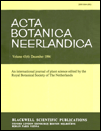Spatial limitations induce spindle tilting and result in oblique phragmoplasts in Vicia faba L. root tip cells, but do not result in oblique cell walls
SUMMARY
Chromosome and phragmoplast positioning proceed differently during mitosis and cytokinesis in short and long root tip cells of Vicia faba L. and has been studied previously (Oud & Nanninga 1992, 1994). No correlations, however, were made with the microtubular cytoskeleton. Here this correlation is investigated using longitudinal sections of hydroxy-urea synchronized root tip cells. Microtubules were labelled with anti α-tubulin, chromosomes were stained with propidium iodide, and both were visualized using confocal scanning laser microscopy. Preprophase bands of microtubules were always positioned in the midplane of both short and long cells, and they were perpendicular to the length axis of the files of cells in the root. Also spindle formation started in a similar way in short and long cells, but from meta- to anaphase, the spindle axis in short cells increasingly tilted, due to spatial constraints. While chromosomes separated, the spindle axis acquired a position inclining to a diagonal of the cell, thus giving rise to the earlier observed oblique chromosome positions in anaphase plates. In short cells oblique phragmoplasts/cell plates expanded in oblique division planes. However, after karyokinesis, oblique cell plates rotated towards the transversal plane and the final site of wall connection was not eccentric, but at the site of the earlier preprophase band. We conclude that the suggestion that, in Vicia faba L., oblique walls are due to oblique anaphase plates (Oud & Nanninga 1992), has to be corrected. Even when chromosomal alignment is offset and oblique cell plates are formed in cramped cells, transverse preprophase bands still predict transverse division planes.




